
Southern Command by Roger Keating, Australia, published by SSI, USA
First release : November 1981 on Apple II
Tested on : Apple emulator
Total Hours Tested : 7 hours
Average duration of a battle: 4 to 5 hours
Difficulty: Hard (3/5)
Would recommend to a modern player : Maybe
Would recommend to a designer : Yes (level-design only)
Final Rating: Still interesting
Before reading this review, you can start the (long) AAR here.
Literally hours after completing his second game Operation Apocalypse, Roger Keating returned to Australia – but it was certainly not the end of his relationship with SSI. With Operation Apocalypse, he had produced in record time what was possibly the best wargame on the market (Eastern Front 1941 had not been released yet), and there was no reason to stop there. He and Joel Billings agreed on another wargame in a more modern settings : Southern Command.
While the Yom Kippur War is unfamiliar to us, it was eminently familiar to wargamers in 1981 : those events had happened less than 8 years prior, and it was a glimpse of what war in the future would look like. In his 1980 Complete Book of [Tabletop] Wargames, Jon Freeman states “The Six-Day War of 1967 and the October (Yom Kippur) War of 1973 were everything a gamer looks for in a war: fast-moving, decisive, purposeful – a triumph of tactics and technology. The lure of the situation and the chance to use modern armor and weaponry has proved irresistible to designers and gamers alike.” Indeed, while Keating credits SPI’s Chinese Farm (1975) in the manual, he had an handful of tabletop inspiration to choose from : Bar-Lev (1974 already !), The Arab-Israeli Wars (1977), Across Suez (1980), …
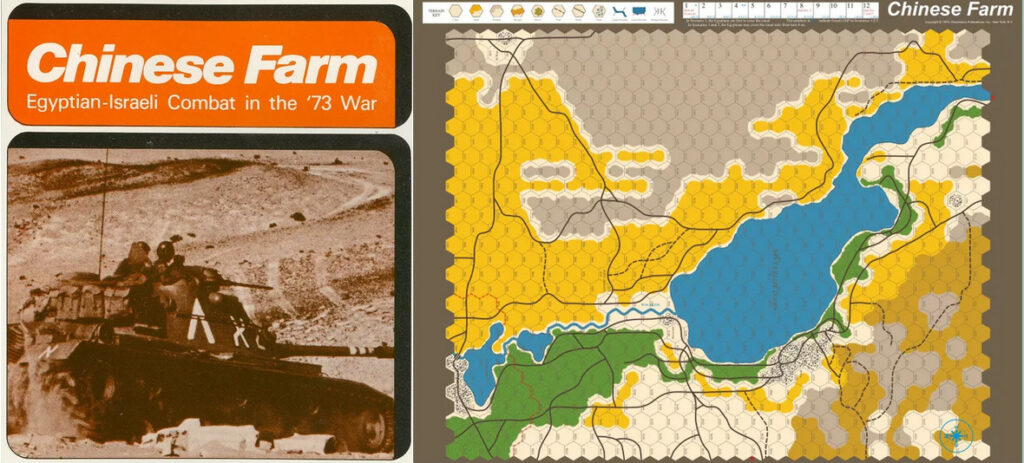
Southern Command looks like Keating’s previous games, but under the hood it is totally different. After Operation Apocalypse, Keating pledged never to code in BASIC again, so Southern Command was rewritten from scratch in Assembler. This gave the game incredible speed. As for the gameplay, on the surface it plays like Operation Apocalypse, but the balancing has been changed so much playing Southern Command like you would Operation Apocalypse is a recipe for disaster.
In spite of being in my opinion a superior game to the $59.95 Operation Apocalypse, Southern Command was sold at the lower SSI pricepoint ($39.95) ; granted the content of the box was limited compared to earlier SSI games :
- A short 10-pages manual,
- Two-reference cards, one of which included a map :

There was only one version of Southern Command (it directly included Roland Gustafsson’s magic RDOS piece of code) so let’s jump to the rating !
A. Immersion
You’d better have a good knowledge of history, because the manual will not help you make sense of the situation. This is the only information available in the manual :
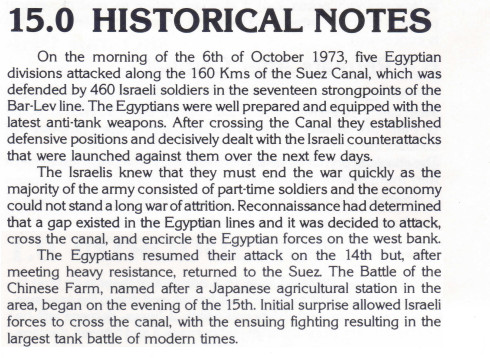
As much as I regret the lack of historical context in the manual, the game is immersive. The immersion does not come from the realism of the ruleset itself, but from Keating’s strong “design-for-effect” philosophy : individually the rules don’t feel realistic, but the ebb and flow of the battle feel just right. The game possibly actually feels more realistic than Keating initially aimed for. Keating retells that once he got a call from Joel Billings, asking him in which publication he found the range of one of the units in the game, as Billings could not find it in any source. Keating just answered “it sounded like a good range at the time.”
There are a few things I am not too satisfied with though.
- Reorganizing (=healing) units really breaks immersion due to how unrealistic it can be. You can just reorganize to almost 100%, even well behind the enemy lines, as if you could repair all the vehicles and heal all the lost soldiers. There is no long term attrition. In Operation Apocalypse, there was a de facto limit on how much you could reorganize.
- Air force is unrepresented and lackluster compared to its historical importance.
- I also wish I knew what vehicles & weapons I am using instead of generic “tanks”, “motorized infantry”, etc.
- Finally, this being 1981, the graphics are not quite there yet.
Rating : Acceptable.
B. UI , Clarity of rules and outcomes
One of the first things a player will notice is how fast the game is : there is absolutely no loading time in the game. I might even say it’s too fast : #1 reason for which I did not ironman the game is the volume of input errors due to the game speed. For instance, I give an order to a unit by pressing a direction 3 times, but the unit can only move twice before exhausting its movement points and what do you know, the next unit is moved as per the third input right into the worst possible position. This happens even with an emulator slowed down compared to historical speed, testament to the quality of the programming and the power of Assembler. Clearly this problem was so new in 1981 that no one thought it wise yet to introduce a simple system cancelling all inputs when you switch to the next unit.
The good news is that this extraordinary speed applies to scrolling, though it is not as smooth as in Eastern Front 1941, but also to AI. The AI plays its turns in roughly one minute at historical Apple II speed.
The UI is a mixed bag. Southern Command fixes most of the issues of Operation Apocalypse (freedom to move the units in any order, no more timers during your turn,…) but the game is drowning in its own complexity, in particular with regards to mode (transport / attack / defense / reorganize / …) :
- Some modes can be changed to by using the “C” key, others need you to use Ctrl-O.
- You would think that switching to Fire stance would allow you to directly fire at enemies, but no, having switched to Fire mode you also need to press Ctrl-F to actually shoot at something (reason #2 for not playing Ironman : I kept moving my units by mistake toward what I was supposed to shoot at).
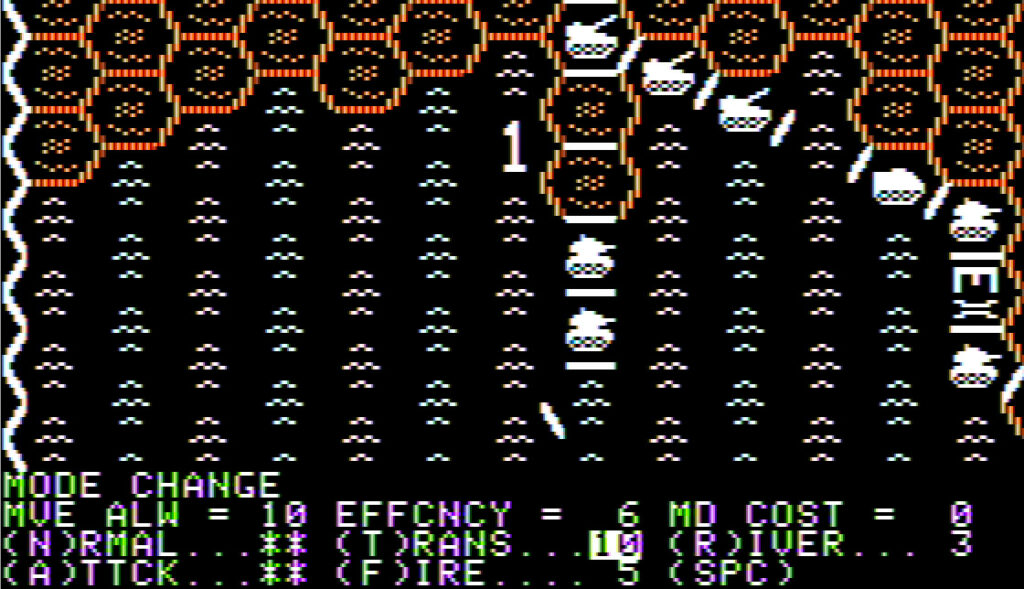
- The game could have quite simply implemented a cost to cross a river, but instead you have to switch in & out of river mode. If you forgot to switch out of river mode, well, the game will happily let you take the road with your vehicles on pontoons and your soldiers in swimsuits, draining all your movement points.
You can find the same complexity in the manual. The rules aren’t easy to start with, but the manual is also full of fine prints – some of them absolutely critical.

Finally, the game does not fix two issues Operation Apocalypse had :
- your hidden units also being hidden to you – though at least you know where they are as you move them,
- the lack of feedback on combat results – all the more frustrating since you could theoretically calculate it yourself with the manual except for the random factor – so why hide it ?
Rating : Poor.
C. Systems
The game builds on Operation Apocalypse, so in a nutshell it’s all based on unit type and unit mode. Modes are roughly the same, with the only addition of “prepared defense” and the merge of “river” and “bridging” mode.
In combat, the game still uses a Combat Result Table, but it is quite different. This was the CTR in Operation Apocalypse :

And here is the one in Southern Command :

- No more dice roll, the randomness now is only a +/-1 column shift,
- No more columns between 0 and 1, they are replaced by negative values, obviously for column shifts,
- The results are way more punitive for the attacker. You don’t deal any damage if you are only somewhat stronger than the defender and you don’t trade equally before the fourth column,
The most important difference though is the number of column shifts available : 8 of them. From the point of view of the attacker, they are :
- 0 to -3 column shifts depending on the defender’s terrain,
- +2 for each allied unit also in contact with the enemy. Given you can stack 2 units per hexagon, it can easily be +4 or +6, especially since there are a lot of units in the game so it is an easy column shift to have,
- -2 for each enemy adjacent to the attacker – easy to avoid,
- -2 to +4 depending on the type of the attacker vs the type of the defenders,
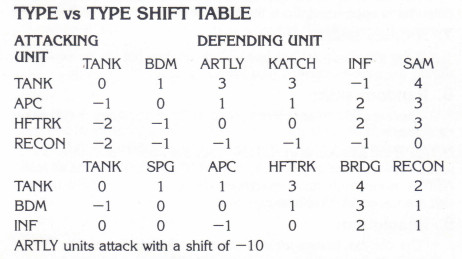
- -3 to +5 for the mode of the attacker AND then again for the mode of the defender,

- Typically -3 to +3 for the effectiveness difference (of course, it can go up to +/- 7 but that’s rare),
- +2 if the target has been hit by a ranged attack this turn ; almost every unit has can do ranged attack so you will always make sure to have this modifier,
- +/-1 randomly,
Therefore, the combat result typically starts somewhere between columns 0 and 2, and could end at +12 or +14… or -6 or so if you suddenly encounter hidden units in defensive position. Strength is mostly irrelevant, except for badly depleted units, what matters most is number of allied units for those sweet and repeatable +2 column shifts. Not really realistic in itself, but as I explained it forces the player to play historically (concentrate, or lose).
Artillery/ranged attacks are even more complex to calculate but the final result is bracketed between 1 and 3 damage so you don’t care much about the details . Airstrike work exactly like artillery, without the brackets but with SAM sites in proximity cancelling damage. The Egyptian player can deploy its own airforce twice in the game, the only effect is that it prevents Israeli airstrikes.
Unlike Operation Apocalypse, most non-artillery units cannot be fully destroyed by artillery or airstrikes, and units who can retreat will retreat rather than take damage in melee, forcing you to surround the enemy if you want to destroy it.
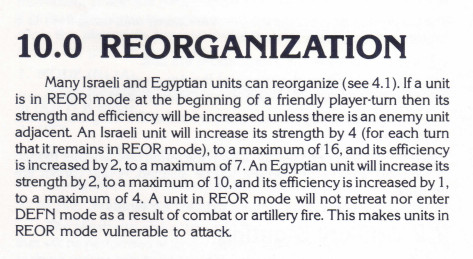
The game has quite a few systems other than combat, for instance the manual gives minute details on sighting rules depending on terrain, mode and whether it is day or night, though it is another case of over-designing since in 90% of cases you will pick one of those modes that just ignore “sighting distance” rules.
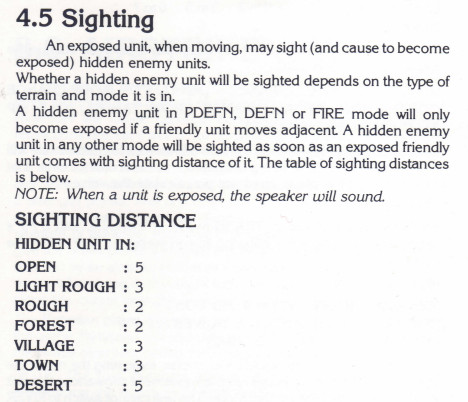
The most important extra rule is “delayed movement”; I did not use it much myself but it can be absolutely devastating if properly set-up. In multiplayer, it must be the difference between a good player and a great player.
As I said, the rules are complex, but eventually, after a couple hours, you will know whether an attack will work or not, and how much damage your artillery caused to your target. After that, it really works well and the game is a lot of pleasure, sometimes frustrated by some weird individual values here and there (are Katyusha really that much harder to destroy for a tank compared to a SAM site ? Why is defensive mode so useless for non-INF units ?).
Rating : Quite good
D. Scenario design & Balancing
There is only one scenario (either 10 turns or 20 turns long) but boy is it well designed. I actually love those “one-shot” games where you read the manual, play a few turns to understand the rules, and then try to play it for real only once, and accept the results. That’s probably why I liked Computer Napoleonics a lot more than it objectively deserves.
For such a test of skill, Southern Command is one of the best scenarios I have ever seen, on this blog or not. The opening situation is complex with a lot of options, and you will immediately give yourself secondary objectives (clear the road, remove that unit, …) but at the same time the game is fluid enough that you never just mindlessly mop-up the enemy. Maybe you have a tactical superiority somewhere, but so many “local situations” get created organically that when you have local superiority you still have to make a decision : leverage the advantage, or reallocate troops somewhere else. This high tension is maintained for most of the game.
As much as I like the scenario, I found the AI weaker than in Operation Apocalypse. It is pretty good with its delayed movement, but it is too passive for most of the game (I initially thought it was designed like this on purpose to mirror historical Egyptian behavior, but Roger Keating told me it was not the case) and for some reason it does not seem to know that it needs to surround units to destroy them. Due to this, your units are extremely rarely at risk, and the tension I described above is not on losing units, but on trying to complete all your objectives in time.
One exception to the resilience of your units : your 2 scout units, which for some unfathomable reason cannot reorganize and can be destroyed fully by artillery. Due to this, by mid-game you will park them somewhere and just skip them every turn. A bit frustrating.
But again, AI and some inconsistencies are forgiven : the scenario is just that good. As I write this report, I am still wondering what would happen if I abandoned the center and rather tried to pour left and right to reach the Egyptian artillery and isolate the infantry :
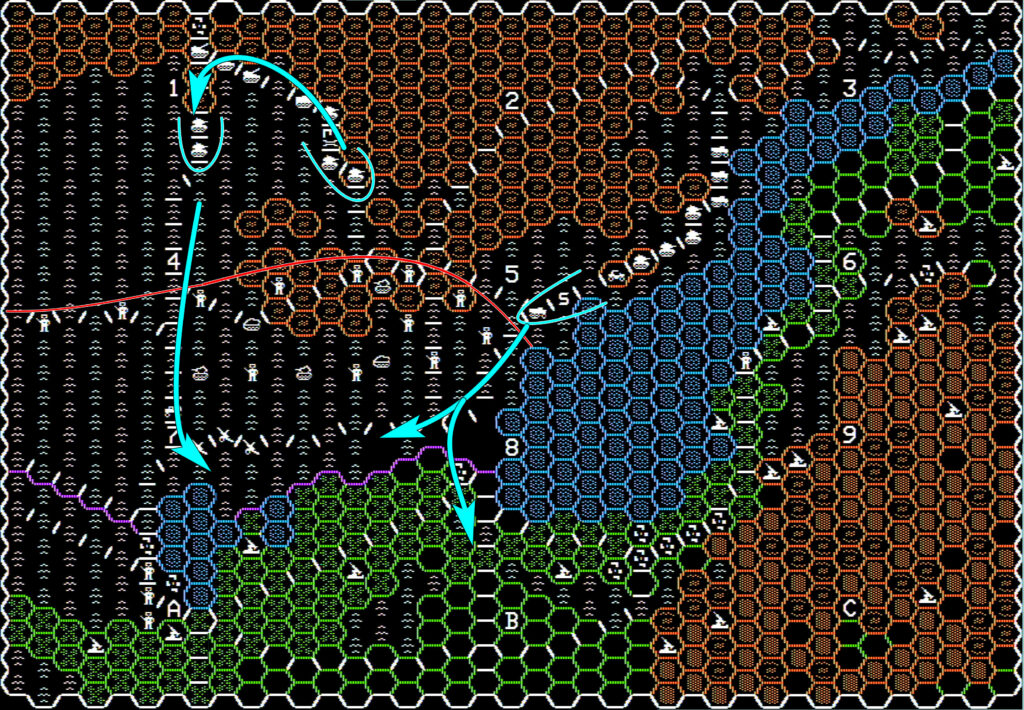
And what about ignoring the artillery and crossing on both sides immediately ?

I want to retry, but this game is 4 hours long and I need to move on. If some of you want to organize multiplayer games, I am a taker though.
Rating : Good
E. Did I make interesting decisions ?
Yes, every turn, both strategic and tactical.
F. Final rating
Southern Command is a game I can recommend, if primitive art and UI are not a turn-off and if you can accept doing mistakes for a couple hours before really getting the game. Still interesting
Rating : Quite good
Contemporary Reviews
The game received only very few reviews, but what reviews ! Bob Proctor in Computer Gaming World (March-April 1982) allocated no less than 4 pages (10% of the magazine) to his review, and described the gameplay in great details. Just like I did, Bob Proctor deeply respected the computer usage of “delayed order” “I confess I haven’t mastered this yet, but the computer uses it […] and it has caught me in several nasty ambushes.” Proctor also praised the game for its speed (“it’s almost too fast to follow” – so it was not only my emulator !). In any case, Proctor called the game as good as Eastern Front 1941, and concluded : “Southern Command is an outstanding game and a very realistic historical simulation […]. I urge you to try it too.“
Amusingly, I also found a review of Southern Command in Your Computer (January 1982), an Australian magazine which of course loved Roger Keating’s game. They found the computer opponent to be “formidable” and report failing to beat it, and also lauded the game for its “attention to detail and realism“.
Southern Command was even appreciated by the notoriously hard to please French reviewers of Tilt. In their March 1984 wargames review, they gave the game a solid 5 stars out of 6 (only later Keating games received six stars), Tilt calls Southern Command a “very high level software” that leverages the computer’s capabilities to the maximum.
Most of the acclaims for Southern Command can actually be found in reviews… of Keating’s later games. Reviews of any game designed by Keating in 1982 or 1983 start by something along the lines of “Roger Keating, author of the critically acclaimed Southern Command“. Even later articles will replace that with “Roger Keating, author of the critically acclaimed Reach for the Stars”, but we won’t get to that before 1983.
5 Comments
“The Battle of the Chinese Farm, named after a Japanese Agricultural station in the area”
This cracked me up… but it turns out it wasn’t even technically Japanese:
(https://en.wikipedia.org/wiki/Battle_of_the_Chinese_Farm “near an Egyptian agricultural research station. The area was known to the Israeli military as the Chinese Farm – a misnomer resulting from the research station’s use of Japanese-made equipment. (Japanese Kanji characters on machinery at the farm were mistaken by Israeli observers for Chinese Hanzi.)”
mixing up kanji and hanzi seems like an easy mistake to make considering how closely related the two are. Also maybe Israeli would have more expected Chinese equipment than Japanese, considering the good diplomatic relationships between Egypt and China at the time
After playing this I agree that it’s very well designed and balanced scenario. Despite the complex UI I enjoyed playing it and despite some unrealistic rules felt immersed throughout the game. The amount of decisions to make every turn and the timetable for completing the objectives being quite tight really keep the tension up.
During the last couple of turns, when I had so many of my units battered down to their last couple of strength points, the tension was especially high while watching the enemy turns. However, those turns also really showed that while the AI is very good at creating ambushes it’s not good at attacking. After the dust settled and the game ended it started to feel somewhat unrealistic that I didn’t lose a single unit while Egyptians lost over 40 units during the battle.
Considering the weakness of the AI at the end, the Egyptians having so much more units, and the punishing cost of losing units for Israel, my assessment is that if Egyptian forces were commanded by a human player Israel wouldn’t have much hope for a victory.
Ah, really interesting review! You should do more! Nice to see a contemporary shares my opinion, particularly about the scout units :).
I believe the game is not that unbalanced in two players: first you probably played with the “reinforced Egyptian units”, and without it the dug-in infantry is much weaker iirc. Also keep in mind that the “Prepared Defense”, which really helps the Egyptian, is lost when moving and can never be used again, so all those infantry units in the middle lose their impressive defensive bonus. Finally, the hidden rule in 4.9 [ No Egyptian unit may enter RIVER mode, but they may cross the canal at the Ismaili bridge after turn 8.”] is probably going to throw a spanner in any Egyptian plan.
Thanks, most likely will do more in the future. Ah, the scout units, my first attempt revealed that the AI likes to prioritise them as targets for artillery. That was a devastating lesson.
You are right, I played against reinforced Egyptian units, so against regular units life would be easier for the Israeli player. That, together with that crossing rule, would provide a real challenge for Egyptian player; how to slow Israel enough so that those reserves can turn the tide.